 Something about this photo gives me the heebie-jeebies
Something about this photo gives me the heebie-jeebies To start out on our route we headed via airplane from Iquitos to Lima, in order to save a week or more of time (the other option was another multi-day cargo boat from Iquitos since it has no road access, followed by a 24+ hour bus ride). We didn't spend much time in Lima before departing to Pisco to visit the Ballestas Islands and Paracas National Reserve, and to unexpectedly experience a 5.7 magnitude earthquake while face-timing with Donna and Jim, Andrew's parents. The next stop on the Gringo Trail was Nazca where we saw for ourselves the infamous Nazca Lines and learned a lot about the ancient cultures that inhabited the area between 100bc and 800ad, and then spent the next few days barfing due to the horrific flight over the lines and/or some bad food or water, who knows what. After Nazca was Arequipa, the second most populous city in Peru and the hub to get to the beautiful Colca Canyon (but we decided not to go there since it was a bit far and really expensive). Finally, we arrived in Cusco, our base for some intense Shamanism and of course, to visit Machu Picchu. Next and last on the list (heading out this afternoon via bus) will be the town of Puno where we can visit Lake Titicaca before crossing the border into Bolivia. We can really see why so many people travel this route: the diverse beauty and culture have taken our breath away almost every day since we have arrived.
Gringo Trail - click on the icons for information
Iquitos
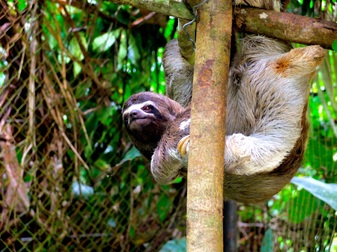 Chili sloth
Chili sloth On one day while our muuuuuuch needed laundry was being done we wandered around the Belen Market, where one may find almost any kind of medicinal plant (or animal for that matter) you can think of. Of course, as is always wise while wandering in local markets, we only took out our camera a few times and made sure that not many people saw us with it, and we left anything else of any value back at the hostel.
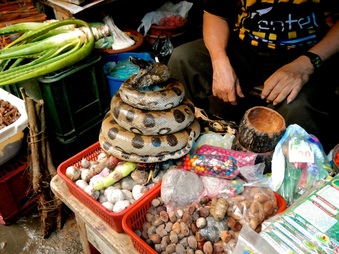 You name it, they have it
You name it, they have it 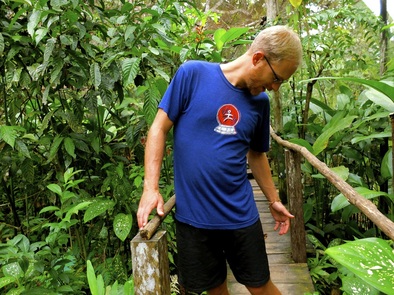 And that is my husband with a butterfly....
And that is my husband with a butterfly.... Luckily, after a few minutes we came out the other side of the swampy "island-thing", noticed the Pilpintuwasi sign and realized that we had made it after all. Perhaps we're just a bit too paranoid. The driver parked and waited for us while we explored the reserve (we didn't realize that we had hired him for the day, lol, oops). We were first greeted by the ugliest monkeys in the universe (Uakari, a.k.a. red faced monkeys) with their little creepy red faces. They just ran around, jumping from tree to tree and chilling out on the deck near the manitee pond. We were asked not to touch the monkeys, but managed to get some silly photos with them. Next we were herded into the butterfly cage area where there were all kinds of plants and mariposas maravellosas! (marvellous butterflies)! For some reason they kept on landing on Andrew and for a while he looked a lot like a dainty fairy. It took a few days before I agreed to call him Mandrew again. Later on, we toured the property with a volunteer who showed us Pedro the GIGANTIC Jaguar, who had been rescued from poachers years earlier, as well as Gudrun the playful and attitudy Ocelot who was confiscated from the Belen Market by some good-natured tourists. There were also many kinds of sloths and monkeys, one of which had been rescued from a street gang (he was trained as a pick-pocket but left to starve after failing to please the gang members), and many others confiscated from poachers and toursits at the airport, especially the very small monkeys (people like to take them home as pets). Perhaps the weirdest animal there was a giant ant-eater. It was very young but still the size of a large husky, and since its diet is mainly ants, ants, and a lot more ants, it needs to spend most of its day outside of the reserve searching for ant hills to scourge. To allow this to happen, there is one man who works with the ant-eater EVERY DAY for several hours, just following it around the jungle looking on its search for ants. I imagine that job would be fun for about 25-30 minutes, and then would get very lonely! However, he apparently likes his job a lot and has a very close relationship with the little (big?) guy. We had such a great time at the reserve and highly recommend a visit if you ever happen to be in Iquitos, but maybe take one of the collectivo boats (which we thought we were doing at first) that takes many people - safety in numbers!
Lima
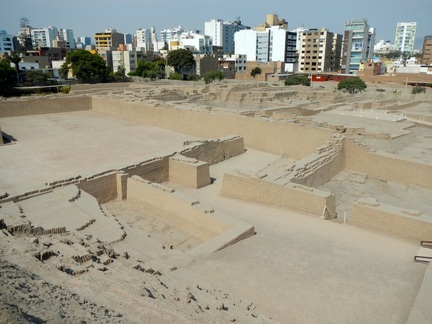 Ruins and city, all in one place
Ruins and city, all in one place We spent our one full day wandering around Miraflores (a.k.a. Gringolandia, lol), a very fancy and touristy area with lots of fun shops and restaurants, and then we took a tour of Huaca Pucllana, an ancient pre-Inca adobe and clay temple constructed between 200 and 700ad, that was amazingly only officially discovered in the late 1960's by a condo building company (even though there is evidence that road construction crews MUST have found it earlier but didn't say anything because they wanted to keep working - similar to if a mining company found an ancient arrowhead in the middle of an open pit, lol). Before heading back to our hostel in the old part of the city, Breña, where all of the big fancy buildings are, we swung by the coast and hung out in the parks high on the cliffs above the ocean. The views were incredible! It really was a beautiful place. But it is a city after all, and we were anxious to move on to a another national park!
Pisco
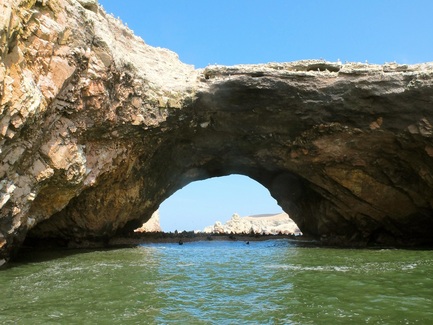 The Islas Ballestas were soooo pretty!
The Islas Ballestas were soooo pretty! We took a bus from Lima and arrived in the late afternoon. It was a small town with a friendly vibe but we quickly realized that there were absolutely no living plants for miles! We were directly on the coast, ocean in view and everything, but it was a complete desert along with sand dunes and the whole bit. After the long bus ride in we thought we would go for a run to explore the town a little more. I don't think many people run in Peru, because we got the craziest looks from people, and later when we went out for dinner someone recognized us at the crazy running people.
We booked a full day of tours for the next day (my birthday) and settled into the hostel for the night. Before hitting the hay we gave a couple phone calls to family, and during our face-time chat with Donna and Jim we experienced a full on 5.7 magnitude earthquake, centered about 100km away in Ica! Once we realized what was going on, we turned the computer so we could still see each other, and Jim and Donna watched us shake away for a few minutes, while we hugged the concrete column at the designated seismic safe zone. It wasn't strong enough to do any damage but it was definitely exciting! The locals hope to feel something at least every six months: any longer and that just means that more pressure is building up, along with the potential for a larger quake, as well as tsunami.
 Reserva Nacional de Paracas
Reserva Nacional de Paracas Nazca
 We come in peace...
We come in peace... After our time in Nazca, Andrew's sure he's solved some of the important mysteries surrounding the lines, and has presented his irrefutable arguments here.
Arequipa
 Arequipa & it's gorgeous backdrop
Arequipa & it's gorgeous backdrop Cusco
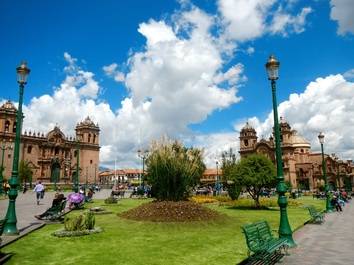 Plaza de Armas
Plaza de Armas Instead of the very busy and more expensive Inca Trail to Machu Picchu, we elected to do the Inca Jungle Trek ($185) which included a day of downhill biking, followed by two days of hiking to reach Aguas Calientes (aka Machu Picchu City), and a day to explore the ruins. Everything was set except for the looming city strike that was planned for the next morning, our departure morning. As instructed, we were ready to hit the road at 2:30am in hopes that we would be out of the city before the roads were blocked, but soon enough it was evident that we were not going anywhere. We were told we would try again the next morning but we figured this would just mean another wasted morning of sleep...
This extra day in Cusco really made things interesting for us. We figured we still had time to see Machu Picchu and make the meditation course, as long as we very quickly left for Bolivia afterward. While wandering around the city, however, we stumbled on another option that was a bit more intriguing. After some consideration, we changed our plans and swapped the ten day Vipassana course for a three day traditional Shamanistic retreat. Quite an interesting experience - we'll write more about this in an upcoming post. =)
Machu Picchu
 The rain and clouds made it more green and surreal!
The rain and clouds made it more green and surreal! 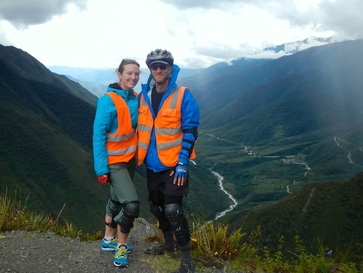 Posing seconds before the lightning struck
Posing seconds before the lightning struck 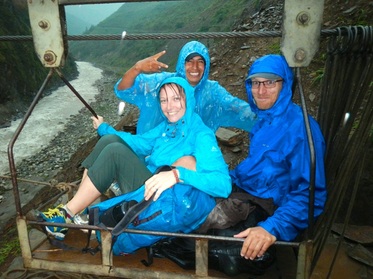 The "local transportation" across the river
The "local transportation" across the river 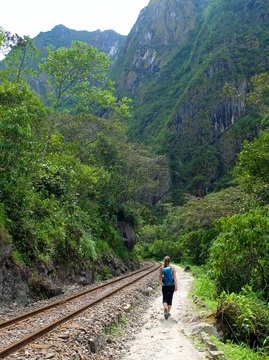 We felt so small amongst the giant mountains
We felt so small amongst the giant mountains 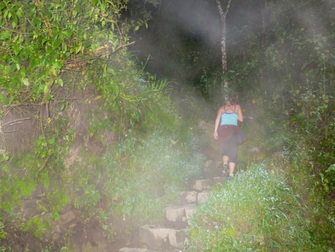 The seemingly endless steps up to Machu Picchu
The seemingly endless steps up to Machu Picchu To end the day we took a bus back down to Aguas Calientes (a complete rip-off at ten bucks each, but we were absolutely beat) and had just enough time to grab a quick dinner, ice cream cone, and snickers bar, before catching our train & then bus back to Cusco. What an amazing trip - it will definitely be tough to beat! We still haven't figured out how the company charged us so little. If we were to do it on our own, given the entrance and train fees, hostel stays and food, we could not have done it for less. Rainy season is the perfect time to come here (though it does rain quite a bit...) :)
Inka Jungle Trail Photos
Machu Picchu Photos
Puno & Lake Titicaca
 The floating Islands, everything's made of reeds!
The floating Islands, everything's made of reeds! The following afternoon we went on a few hour tour of the nearby floating islands, one of the more interesting aspects of Lake Titicaca. I should first mention, that despite the name, the lake does not seem to have anything to do with titties or caca (much to Mandrew's disappointment). At any rate, the floating islands are a group of more than eighty small islands made completely out of beds of dried reeds that grow in the area. About 700 years ago, a conflict between two groups of indigenous peoples led to one of the groups constructing islands and floating them out into the lake. Although the conflict ended soon after, these people have continued to live completely separate from the mainland (although they depend on Puno for things such as health care and education past grade three). Even though the tour we did was horribly touristy (quite obviously designed as a way to get tourists to buy their handmade souvenirs and give tips for eagerly-performed song and dance), it was still impressive to set foot on the islands and check out the ornately-constructed reed catamarans.
Until next time, keep bein' chili!
~ Chelsea & Mandrew
 RSS Feed
RSS Feed